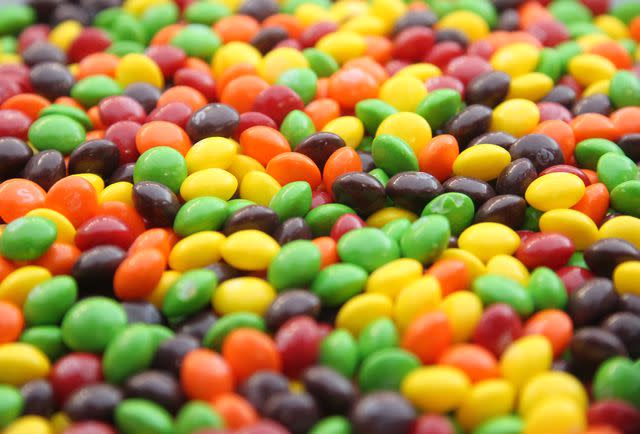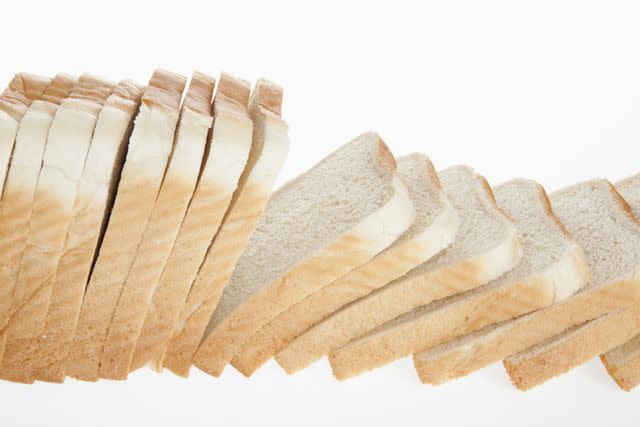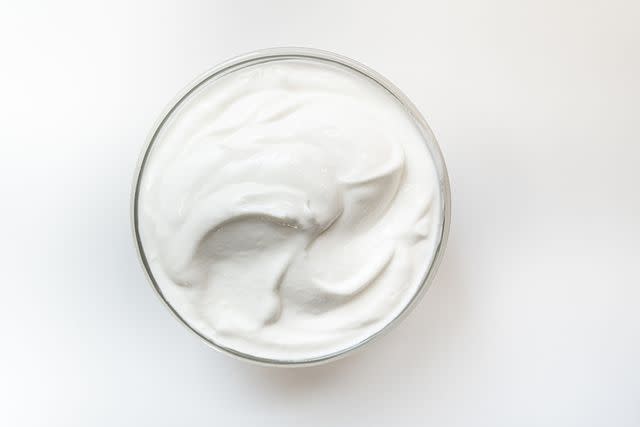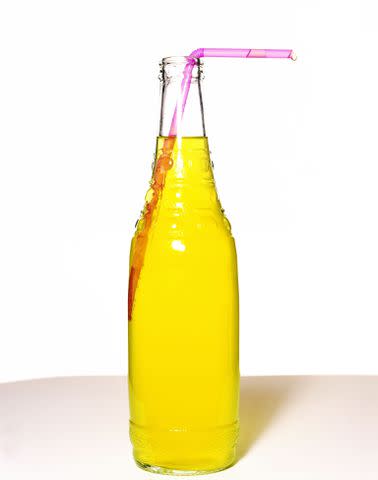Food Additives to Watch Out For—and Where You'll Find Them
You may have foods containing these chemicals—including baked goods, sodas, candy, and dairy products—in your kitchen right now.

Rimma Bondarenko/Getty Images
Processed foods can contain a number of different chemicals to give it a palatable color, enhance the flavor or texture, or keep it fresher and more delicious longer. But some of these food additives have come under fire—including potential bans on their use in foods in California and New York. Studies suggest these food additives may be linked to health concerns, such as disrupting the endocrine system, increasing the severity of irritable bowel disease, or increasing the likelihood of certain cancers.
"These five chemicals pose well-documented risks when consumed," says Lillian Zhou, the Environmental Working Group's Stabile law fellow. "However, titanium dioxide and red dye No. 3 are by far the most widely used today, and both are often found in foods that are marketed to children. Children are more susceptible to toxicological risks because their bodies are still developing and they consume more of the chemical per unit of body weight."
But it isn't necessarily a case of having to trash foods containing these additives if you find them in your pantry right now. "Our concern is about aggregated risks and exposure over time," Zhou says. "It's important to read labels and try your best to make informed decisions."
These are the five food additives that legislators are looking to remove from the food supply—along with the potential health effects and what products may contain them. (You can also check out the EWG's Food Scores to see which foods contain these additives.)
Red Dye No. 3

Otto Greule Jr / Stringer / Getty Images
This artificial food dye, also known as erythrosine, gives foods that bright cherry red hue.
Potential health effects: Red dye No. 3 has been shown to cause cancer in mice, and is one of the artificial food dyes linked to hyperactivity and behavioral issues in kids. The Food and Drug Administration banned red dye No. 3 from cosmetics in 1990, but it's still allowed in food.
Related:7 Ways to Break a Sugar Addiction and Curb Cravings for Good
Where it's found: Red-colored candies are the classic example of products that include red dye No. 3, but you may also find it in red-colored fruit punch or strawberry drinks, frostings, popsicles, breakfast cereals, baked goods, and maraschino cherries.
Potassium Bromate

Potassium bromate is used to increase the strength and elasticity of dough and help baked goods rise when they're cooked. Its use has been banned in several regions of the world, including Europe, the United Kingdom, and Canada.
Potential health effects: Studies have linked potassium bromate to cancerous tumors in the thyroid, kidney, and mesothelium in rats. The International Agency for Research on Cancer labeled potassium bromate as a possible carcinogen for humans.
Where it's found: You'll find potassium bromate in some store-bought baked goods like breads and tortillas and even flour. (It may be listed as simply bromate, not potassium bromate.)
Propylparaben

Propylparaben works as a preservative in both food and beauty products, helping to prevent the growth of bacteria and mold. While some beauty companies have removed the chemical from their products (think those labeled "paraben-free"), it's still found in foods. The European Union has banned its use.
Related:What Are Parabens? And Should You Be Concerned About Preservatives in Skincare?
Potential health effects: Propylparaben may disrupt the endocrine system. Studies have shown a significantly reduction in testosterone levels in male rats, and other parabens in food have been linked to changes in hormones, including progesterone and estradiol.
Where it's found: It's most commonly found in prepackaged baked goods like muffins, cakes, and tortillas, but can also be found in some candy and other products.
Titanium Dioxide

wilatlak villette/Getty Images
Titanium dioxide makes foods or beauty products look whiter and more vibrant. It was banned from use as a food additive in Europe last year, but is still allowed here in the U.S.
Potential health effects: Titanium dioxide has been linked with inflammation and damage to the liver, spleen, and kidneys in mouse studies. Another review of studies found that it could be involved in inflammatory bowel disease and colorectal cancer. A European safety assessment found that it could disrupt the immune system and damage DNA.
Related:The 5 Food Pillars of Eating for Gut Health, According to a Registered Dietitian
Where it's found: Dairy products like creamy or cheesy soups, ice cream, sauces, and dips; drink mixes; candy; and even vitamins.
Brominated Vegetable Oil

Brian Hagiwara/Getty Images
Brominated vegetable oil (BVO) is used in drinks to help keep the flavorings from separating from the rest of the beverage. The FDA removed brominated vegetable oil from the list of "generally recognized as safe" chemicals, but is still allowed in small quantities.
Potential health effects: The FDA's recent studies on brominated vegetable oil found that it increased the possibility of thyroid dysfunction in rats when they were given a dosage similar to humans who regularly consume it. Another study found that it decreased fertility in rats.
Related:If You Love Sparkling Water, We've Got Good News for You
Where it's found: Brominated vegetable oil is usually found in fruit-based sodas and drinks. While most of the major soda companies (including Coca-Cola and PepsiCo) have removed BVO from their products, it can still be found in Sun Drop and store-brand citrus or fruit-punch sodas.
Food additive FAQs
Frequently Asked Questions
How can I tell if the foods I'm eating contain food additives?
Some of the food additives need to be listed in the ingredients. Brominated vegetable oil, potassium bromate, propylparaben, and red No. 3 are required to be listed by name, Zhou says. But federal regulations allow titanium dioxide to be listed simply as "color added" or "artificial color." In butter, cheese, and ice cream, titanium dioxide does not have to be declared at all.
Why does Europe tend to ban more food chemicals?
The answer lies in how European governments and the U.S. government handle reviewing food additives. While Europe requires regular reviews of approved chemicals, in the U.S., the FDA is rarely required to review food additives—even if they were approved decades ago and there's new evidence they pose risks, Zhou says.
Are there any other additives I should watch for on labels?
The EWG points to synthetic colors like red No. 40, yellow No. 5 and yellow No. 6, which like red No. 3 are linked to neurobehavioral issues in kids.
How do I limit my intake of food additives?
Most food additives are used in processed foods, which have been linked to cardiovascular disease and early death in studies, so it's worthwhile to focus on eating whole, unprocessed foods. Think fresh fruits and vegetables, whole grains, nuts, and lean meat and dairy.
For more Real Simple news, make sure to sign up for our newsletter!
Read the original article on Real Simple.

